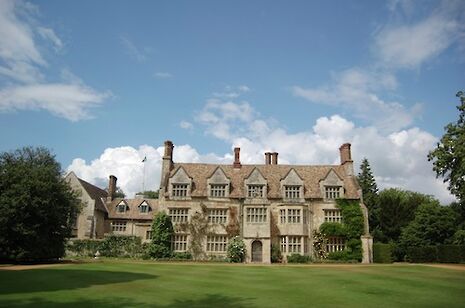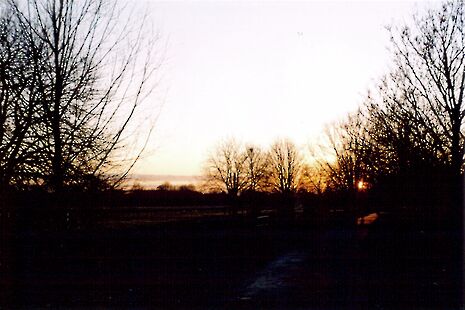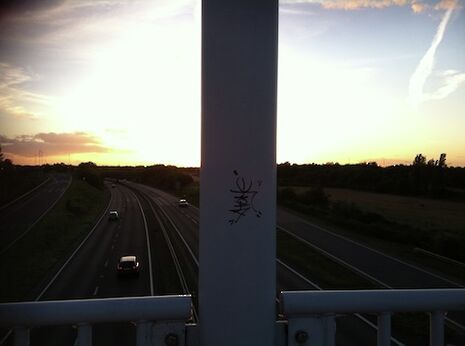Cambridge Escape
Cambridge can, at times, become devastatingly claustrophobic. Fortunately, Oliver Rees and Anna Fairhurst know some of the best places to visit when you need to escape the city.
Madingley Hall
This is yet another occasion when you realise how much Cambridge University owns.The beautiful sixteenth century house looks like something out of a Brontë novel as you approach up the hill from Madingley village. Would you believe it’s a conference and events centre as well as part-time hotel owned by the University of Cambridge?
Admittedly there’s not a huge amount to do there – it’s private property so you can’t go into the house. But there is a lake and beautiful gardens (designed by Labcelot ‘Capability’ Brown if you’re into that kind of thing).
What’s more, there’s a great pub round the corner in Dry Dreyton. (Very local – you will get a few stares!)
American Cemetery

Three miles outside of Cambridge is the American Cemetery. Opened in 1956 on land donated by the University, the cemetery surprisingly doesn’t have the usual depressing feel that a lot of others do.
There are clean lines of white stone and wall after wall of names etched in marble. Kept up by a dedicated team of groundskeepers and military personnel, the grass is always perfectly green and the American flag is always flying.
Similar to the war cemeteries in Dunkirk, the Cambridge American Cemetery contains the headstones of over 3,800 servicemen who died fighting for their country in the Second World War.
The whole space is inspiring and simply incredible – men younger than us who died fighting for freedom and against evil. Walking past the shining white headstones, it is impossible to think of your next essay or night out, simply because of the stunning beauty and sacrifice made by so many great men.
The Gog Mahog hills
In a decree of 1574, Cambridge students were forbidden from visiting the Gog Magog hills on the threat of a fine. Today, you are free to go whenever you wish. The best route is to walk around ‘Wandlebury Ring,’ which was originally a hill-fort but is now a small sprawl of offices and huts. The walk only takes about 20 minutes and takes you in a complete circle; perfect if you don’t have much time!
The area was occupied in the Bronze Age and is rich with history. Walk along the straight Roman Road and through the fields and valleys surrounding Wandlebury Ring. It is almost always deserted so you have to say hello to the occasional dog walker.
Especially for medics spending time in Addenbrookes or those at Homerton, the Gog Magog Hills give a great view of the city they allow you to escape from.
Anglesey Abbey

A little further afield, almost 6 miles outside Cambridge in the village of Lode, you’ll find the Anglesey Abbey estate, now owned by the National Trust (who give you a big discount if you come by bike).
You may think you’ve already seen enough English estates and period dramas to last you at least through your university years, but you’ll find that Anglesey Abbey has a very unique history and character.
The house was once a priory before it was transformed by a series of well-to-do families throughout the centuries (even Sir George Downing, founder of Downing College, made his home there).
However, it wasn’t until the 1920’s that the house really came into its own. The rich heir to a mining dynasty in America bought the abbey to house his eclectic selection of antique and contemporary furniture in a desperate attempt to establish himself as a figure on the English aristocratic scene.
The eccentric bachelor filled the house with an assortment of things from every period and style, and made what, in my opinion, is a great house party venue (though he never had more than four guests at a time!).
Beyond the house there are some beautiful modern gardens, a working flourmill and lots of woodland walks.
Fen Ditton

This village is the perfect place to remind you how lucky we are to live so close to the countryside.
A short walk along the river, heading passed the boathouses, you can roam amongst the cows on Midsummer Common, appreciating the scenic woodland and old English barges moored up beside you.
This is, of course, after you’ve passed the graffiti-ridden railway bridge and the less than discreet chimney of Cambridge’s one and only industrial and science museum.
This is well worth a visit if you happen to go to ‘Fen Dit’ between very fixed hours every first Sunday of the month, under a full moon – check the opening times.It’s no less weird inside when you’re left unsure as to whether you’re in a museum or on an open day at the garage of a steam engine enthusiast.
By the time you get to Fen Ditton, you’ll be in need of light refreshment (unless you opted for the 20p carton of apple juice at the museum), which is fortunate because The Plough pub is just beyond the church in the centre of village.
(Note: the church is always shut so don’t even try the door. It’s probably because the village is neurotic about the threat from thieves – the crime statistics on the notice board suggest it must be one of the safest villages in England!)
Milton

Great pubs are hard to find, especially deserted ones with trampolines and swings. And the bike ride there is half the fun.
Cycle along the river and onto the side with the towpath, opposite Fen Ditton, and then take a left where the rowers have to turn back to town. Go across the level crossing and then take a hidden left about a hundred feet down the path to enter Milton Country Park. Full of lakes and paths cutting through dense trees and undergrowth, this nature reserve feels miles away from Cambridge yet it only takes 15 minutes to reach it.
The Lion and Lamb pub is beyond the industrial estate. After a relaxing bounce and swing, take the bridge over the motorway back (preferably as the sun is setting) There’s a straight cycle route that will take you back to central Cambridge on the road, and will have you home in no time.
 Comment / Plastic pubs: the problem with Cambridge alehouses 5 January 2026
Comment / Plastic pubs: the problem with Cambridge alehouses 5 January 2026 News / Cambridge academics stand out in King’s 2026 Honours List2 January 2026
News / Cambridge academics stand out in King’s 2026 Honours List2 January 2026 News / Cambridge businesses concerned infrastructure delays will hurt growth5 January 2026
News / Cambridge businesses concerned infrastructure delays will hurt growth5 January 2026 News / AstraZeneca sues for £32 million over faulty construction at Cambridge Campus31 December 2025
News / AstraZeneca sues for £32 million over faulty construction at Cambridge Campus31 December 2025 Interviews / You don’t need to peak at Cambridge, says Robin Harding31 December 2025
Interviews / You don’t need to peak at Cambridge, says Robin Harding31 December 2025








